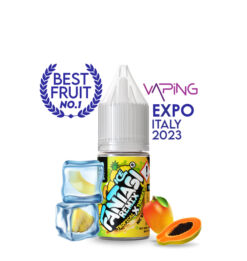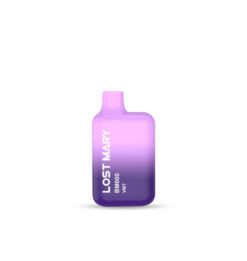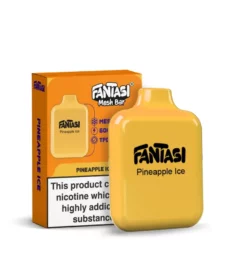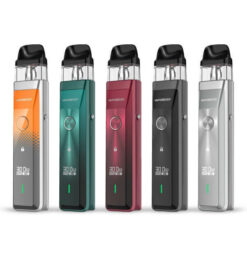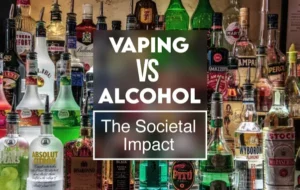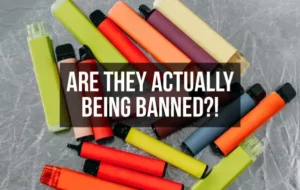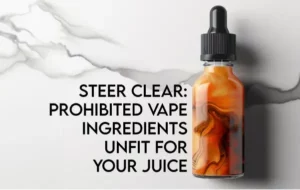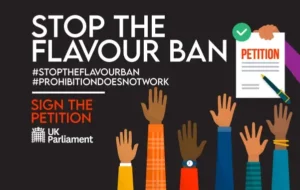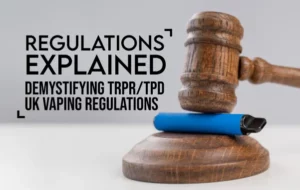The Misinformation of Vaping Products
One of the fastest trends in recent years, vaping has suddenly become a hot topic in the government and news publications, even though it has been a successful quit-smoking tool since the early 2000s and is contributing to at least 20,000 successful new quits per year. But because of the rise of media attention, a lot of misconceptions and misinformation have been spreading around vaping.
The media has perpetuated many false notions in an effort to generate attention, yet the majority of these myths lack substantial scientific backing.
We, at Vapoholic, are specialists in everything related to vaping, so we’re here to debunk any myths you may have about e-cigarettes and help you make an informed decision.

Is It Better to Smoke or Vape?
Most smokers wrongly believe vaping is at least as harmful as smoking cigarettes.
In June 2023, just 27% of respondents to the survey believed e-cigarettes were less harmful than smoking, while 57% of respondents believed vaping was either more or equally bad than smoking.
But why does the British public suddenly believe that vaping is more harmful than smoking?
The NHS and UK government website has said that vaping is 95% safer than smoking cigarettes, vaping does not cause the cancer-causing components that smoking traditional cigarettes does, like tar and carbon monoxide.
Despite this, media outlets have been publishing stories about the recent vaping study with fear-mongering sentences like this: “Fresh e-cigarette health fears were sparked today after an alarming study suggested vaping triggers cell changes which may go on to cause cancer — just like traditional tobacco smoking.”
Then when you scroll down the same article, it’ll say: “Cancer Research UK says there is no good evidence that vaping causes cancer.”
The contradiction is when media outlets choose a clickbait title with scaremongering introductions, but then dispel their own self in the same article, it’s no wonder that the public thinks vaping is as harmful as smoking.
The study in question, by researchers at UCL and the University of Innsbruck, examined methylation, a form of epigenetic modification in which some DNA building blocks become connected to a tiny molecule known as a “methyl group”—which is composed of one carbon atom and three hydrogen atoms.
They specifically looked at methylation in various cell types among smokers, but they also examined it in a small subset of vapers and another small subset of smokeless tobacco users.
So that one above sentence taken from a major news organisation published article said “an alarming study suggested vaping triggers cell changes which may go on to cause cancer — just like traditional tobacco smoking.” But the study never said it “may go on to cause cancer”, another long-term study would have to be conducted to see if that is the case.
Media outlets are already spreading false narratives and disinformation of the study, and causing the public to be worried about using e-cigarettes as an effective stop-smoking aid.
So overall, vaping is still better than smoking, vaping isn’t 100% risk-free, but vaping is only for people who have smoked cigarettes and want to quit altogether. It isn’t for individuals who have never smoked before and have started because of the recent “vaping trend.”

Does Vaping Cause Popcorn Lung?
No, vaping does not cause popcorn lung. Popcorn lung is a rare lung disease that was discovered by a group of factory workers who were exposed to the diacetyl chemical that was used to flavour buttery popcorn.
Inhaling diacetyl causes inflammation to the lungs which then leads to permanent scarring, and is irreversible.
This resulted from the fact that certain flavourings used in e-liquids to give them a buttery flavour contain the chemical diacetyl, which has been linked to the dangerous lung condition bronchiolitis obliterans when exposed to extremely high concentrations.
But diacetyl is a banned vape ingredient in the UK, buying from a reputable and TPD-compliant vape shop, like Vapoholic, will ensure that you don’t receive any e-liquids with this dangerous chemical in.
But yet, there are still publications out there saying that vaping causes popcorn lung, not only has this been debunked, but it has been debunked by the NHS themselves.

Is a Vape Equal to 20 Cigarettes?
No, taking a certain amount of puffs off your vape doesn’t equal a cigarette, there is no accurate measurement for cigarettes and e-cigarette nicotine comparison, and everyone’s bodies absorb them differently.
One major news outlet has claimed that a 20mg vape (this would be a disposable vape) with 40mg of nicotine (this completely contradicts calling it a “20mg vape” and 40mg isn’t legal in the UK) is equivalent to smoking one or two packs of 20 cigarettes. Once again, it is an example of twisting the data to fit the desired narrative.
So it’s understandable that this is a vaping misconception, so let’s break it down.
Each cigarette contains about 10-12mg of nicotine, with claims that you only inhale and absorb around 1.1 to 1.8mg by the end of the cigarette.
For an average smoker, let’s say they smoke around 10 cigarettes per day, on top of all the harmful chemicals they’re inhaling, they’ll also be receiving around 11mg to 18mg of nicotine a day, depending on the brand, from smoking traditional cigarettes.
The government are using the example of a cigarette average containing 11mg comparing it to 20mg per ml of e-liquid.
Let’s do the math, using some assumptions which we will outline below to debunk this misrepresentation.
20mg per millilitre (ML) – Based on the idea that a TPD-compliant 2ml disposable is roughly 600 puffs, and that 1ml is roughly 300 puffs. Approximately 0.06 mg of nicotine is broken down into each puff.
According to information now available, a puff count equivalent to that of a cigarette is approximately 15 puffs. Calculating simply, 0.06 x 15 = 1 mg of nicotine per dosage.
Let’s compare the dosages of 11mg for a cigarette and 1mg for a 20mg nic salt e-liquid.
We don’t have absorption data on e-liquids, so if we were to play devil’s advocate to the tobacco industry and say that 1.1–1.8 mg of nicotine is absorbed from cigarettes, that is still 1.1–1.8 mg per dosage for cigarettes compared to 1mg of the strongest legal nicotine levels allowed in e-liquid in the UK.
However, if you absorbed 100% of the available nicotine in your 15 puffs for some improbable reason, it is still lower and does not support the government’s ridiculous arguments that the proposed tax, particularly on higher strengths, it is unjustified and mathematically inaccurate.
In addition, it makes no sense to any logically-minded person for someone who smokes one cigarette a day to be vaping 300 puffs.
Note that the information above relates to the strongest e-liquid that is legal to produce and market in the United Kingdom.
Even though many of us choose a wide choice of lesser strengths, such as 0mg, the government still wants to tax them at a rate of £1 every 10 millilitres, so that the tax on nicotine-free 100ml shortfills will increase by £10.
So, why is the government planning to add a tax to nicotine e-liquid when it is less nicotine than you’d get from 1 cigarette? It is giving the public the illusion that vaping equals the same nicotine levels, or dangers and health implications, as smoking traditional cigarettes, therefore believing vaping is as bad as smoking.
Vaping evidently doesn’t equal a said amount of cigarettes, not only that, but when you vape you’re also vaping food-grade ingredients, like VG, PG, and flavourings. With cigarettes, you’re also smoking 5,000 chemicals, with at least 70 of them known to cause cancer.

Vaping is Aimed at Children and Causing A Youth Epidemic
Recently, the news has been focusing on vaping being in the hands of minors, but when reputable online vape shops have rigorous age verification checks and TPD-compliant brick-and-mortar stores, how is this happening?
There’s Operation Joseph, a National Trading Standards initiative that is undergoing tackling the supply and sale of illegal vapes and e-cigarettes that has already indicated the answer to the above.
The operation successfully seized more than one million vapes last year, with officers visiting 2,000 retail premises, not only that, they also found evidence that 500 of these stores were willing to sell to minors.
As well as this, North Lincolnshire Council said they have seized around 320,000 illegal vapes worth £2.5 million since 2022.
The problem isn’t the vaping industry, or vapes themselves, it’s unregulated stores importing illegal vapes that are not compliant with TPD regulations, and then willingly selling them to underage children.
So why is the government wanting to add a tax to e-liquid?
Punishing vapers who use vaping as an effective smoking cessation instead of funding Trading Standards to crack down on these brick-and-mortar stores will ultimately lead vapers back to smoking as the high tax will make vaping look less cost-effective.
It is already estimated that one out of every three vapes being sold is illicit.
It’ll only fuel the black market, which is already growing, and soon to be thriving when the UK government bans disposables. The Association of Convenience Stores (ACS) has called on the government to focus on effective enforcement to deal with this, as the black market trade of illicit vapes will receive a £645m boost if disposables are banned next year.
ACS Chief Executive, James Lowman, said:
“Banning something does not mean it ceases to exist. If the Government were really committed to stopping children getting their hands on disposable vapes, then they would focus on cracking down on the illicit trade and enforcing the laws that already exist to prevent children from accessing these products.”
These illicit vapes appeal to children with devices in the shapes of drinks, cartoon creations on them, and ones with LED/RGB lighting around the vape that light up with every puff.
Vaping has only ever been for smokers who want to quit, not for non-smokers and especially not children.
The only way this can be solved is by either a licensing scheme, similar to the alcohol market, or more funding for Trading Standards and Border Control to seize illicit vapes and stop unregulated shops from selling to minors. Simply put, taxing alone won’t address the problem because no one will report to the taxman that they are selling illegal vapes. Instead, effective enforcement of TPD legislation would.
At Vapoholic, we strive to be the voice of the vaping industry, using our expert knowledge to inform and educate our customers.
We have other blogs going into more detail on the health benefits of vaping, how to recycle your vape products, how to vape, government talks, and many more.
We don’t want vaping to have a bad image, and especially not to discourage smokers from transitioning to vaping to save them money, and their health, and live a better life. We understand vaping is a hot topic, but spreading misinformation and inaccurate information is not the way to go about it.
If you have any queries, or worries about vaping, don’t hesitate to reach out and one of our friendly team members will be happy to answer.
You can also contact your local MP to share your opinion if vaping has been successful for you.


